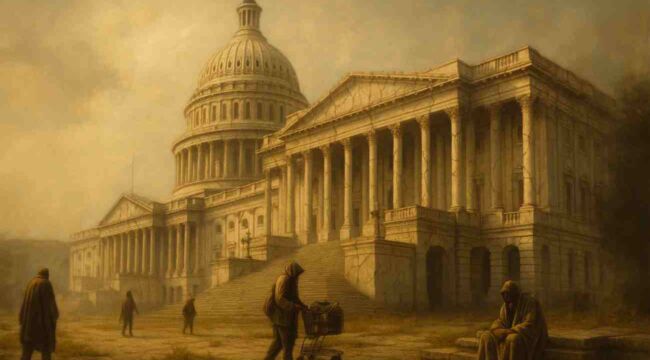Home Improvement
Two big dots — debt and war. Both are growing. What’s the connection?
Today, the Fed lowered interest rates, making debt more attractive. Fortune:
On Sunday night the president told reporters: “I think you have a big cut” to come out of the Federal Open Market Committee (FOMC) meeting this week. He added: “I don’t think he can help but cut. It’s perfect for cutting.”
Trump has been pressuring Powell to cut since winning the Oval Office (despite lobbying for the contrary before the elections). He has even given Powell the nickname of ‘Too Late’ for, in his opinion, being delayed in reducing the base rate as market conditions have changed. Not to miss an opportunity to criticize Powell, Trump added this weekend that the Fed chairman is “incompetent.”
You might wonder, why would a nation with $37 trillion in debt want to add more? To that question, you might want to add a follow-on…why add more debt just to ‘gun up’ for unnecessary wars?
The only way to make sense of it is to summon the ghosts of history and listen carefully. ‘You have no choice,’ they tell us. ‘It doesn’t matter what you want…or how smart you are. An old man can’t decide to be young again. And empires can’t decide not to die.’
How do they die? They spend too much…they get into too many wars…until they are finally busted and beaten.
An empire is a going concern as long as it is expanding — bringing in more booty and tributes. Then, like a large house, the cost of maintenance grows as its inhabitants age. Eventually, the gutters fall off and the old folks retire to more modest quarters.
America’s global empire could not have developed to its present extent without the post-1971 US dollar. A pure-paper currency…the US could print as many as it wanted…and use them to finance both ‘guns and butter.’ At home, just a year after the new dollar was introduced, the US began making cost of living increases to Social Security payments. This greatly reduced resistance to inflation…and assured the system’s eventual bankruptcy.
Overseas, US power expanded to more than 700 military bases…along with widespread military, political and commercial interventions all over the planet. The founding fathers had cautioned against ‘foreign entanglements.’ But by the end of the 20th century, there was hardly an entanglement anywhere on earth that didn’t include the USA.
It may have been the US military that beat Japan and helped to beat Germany…but after 1971, it was the dollar that conquered the world.
It gave the US the ‘exorbitant privilege,’ as Valery Giscard d’Estaing put it, of being able to spend IOUs (dollars!) but never having to settle up. Instead, the silly foreigners kept the IOUs in their vaults as ‘financial reserves.’
The fake dollar twisted up the whole world economy. Without America’s spendthrifts, China’s spectacular growth would have taken generations, not just three decades. And without America’s fake dollars, US industries would have been forced to innovate and compete fairly with the rest of the world. Instead, foreign economies export factory-made goods; America exports dollars, with last year’s trade deficit around $1 trillion.
The new money system distorted just about everything, leaving the world with a vast fake economy… and more than $300 trillion in debt. In the US alone total debt rose from about $1.5 trillion in 1971 to over $104 trillion today.
And where is the output to support it? It doesn’t exist. While debt rose nearly seventy times, GDP rose less than half as much. What this implies is that more than half of America’s total debt since 1971 has no ‘there there’ to justify it…or to pay interest on it.
And now, America’s mansion has been built – mortgaged at a fake rate. The roof was already leaking badly when Donald Trump was elected in 2016. But when he got into office again in 2021, he went back to Washington with a wrecking bar.
First, he set to work dismantling the global trade system and turning the dollar into a weapon. Sanctions and tariffs could be turned on — for almost any reason. If the US disapproves of a nation’s labor laws, its foreign relations, its foreign policies or its drug industry — it could be slapped with devastating tariffs.
But this only accelerated the search for alternatives to dollar dominance. Warming up to one another, for example, China, Russia and India have a combined consumer market about eight times the size of the US. And it will not be too long before they assert themselves militarily as well as commercially. World Politics Review:
China Is Quietly Becoming Its Neighbors’ Biggest Arms Dealer
Over the past 15 years, China has increasingly become the dominant military power in Southeast Asia and parts of South Asia. It has done so primarily in the way that defense experts and political leaders usually think of military dominance: de facto control over large swaths of a region, and the ability to fend off other major powers.
It won’t be long, either, before they have a new common financial reserve that is not the dollar.
Stay tuned…



Comments: